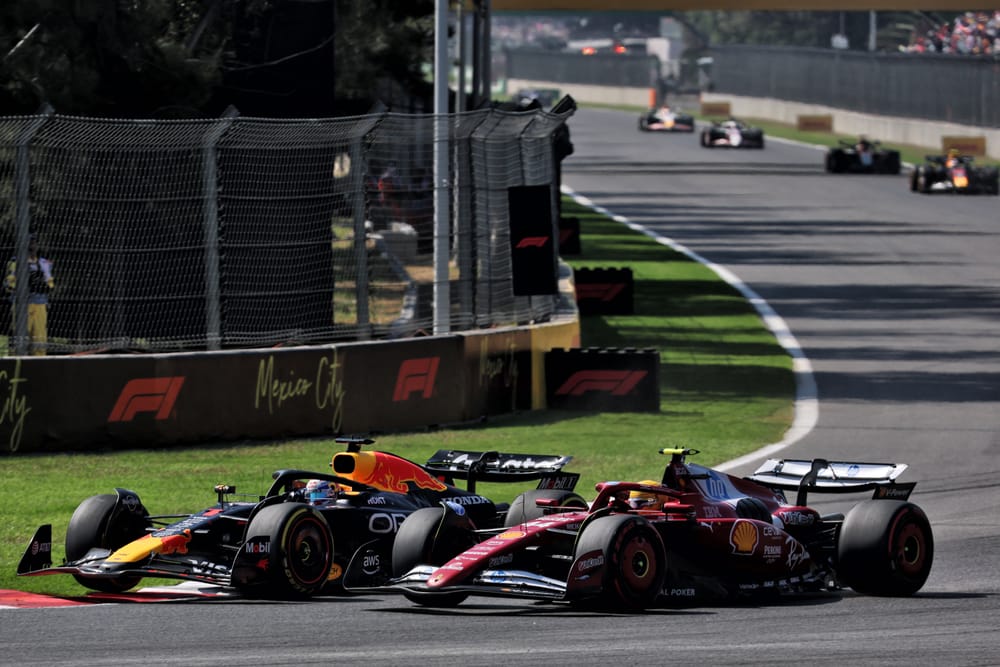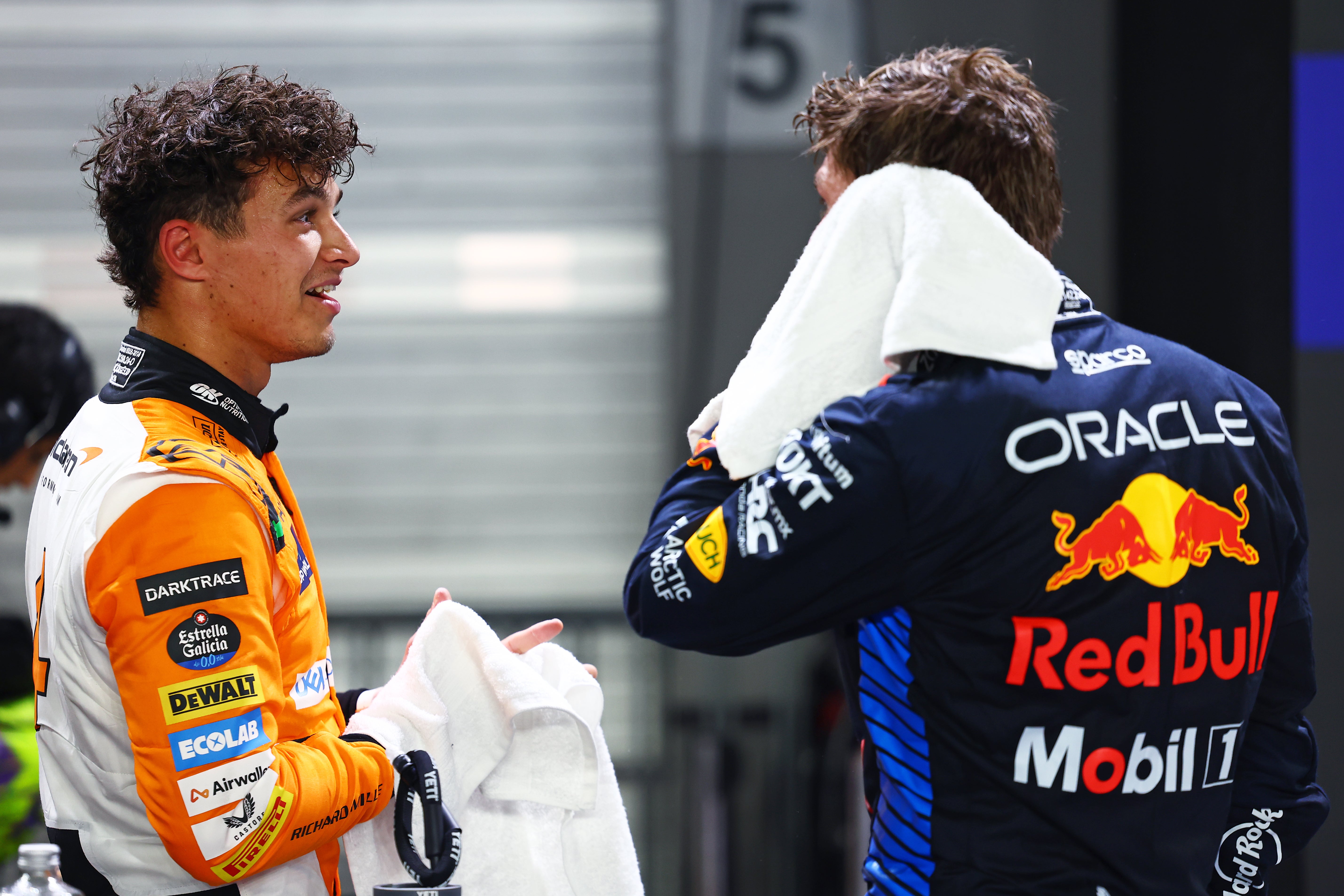The world of Formula 1, an arena where fractions of a second decide fate and glory, has once again found itself engulfed in a debate that transcends the technical and dives deep into the politics of fairness and governance.
The fallout from the Mexican Grand Prix delivered a one-two punch of drama: an explosive accusation of “double standards” from seven-time World Champion Lewis Hamilton following a controversial penalty, set against the backdrop of Lando Norris’s quiet but profound psychological and physical resurgence.
It is a tale of two rivalries—one a highly public feud over regulation and consistency, the other a private, internal battle against data and doubt—both of which illustrate the intense mental and political pressure that define success at the pinnacle of motorsport.

Hamilton’s Fury: The Double Standards That Threaten Trust
The flashpoint occurred during the high-octane action of the Mexican Grand Prix, specifically during a gripping on-track duel with his perennial rival, Max Verstappen. The incident was not the first time the two drivers had tangled on the circuit, but this time, the consequences drew a bitter and public rebuke from the Mercedes driver.
The battle reached its peak on Lap 6, where Verstappen executed an aggressive move down the inside into Turn 1. Hamilton held his line, leading to an inevitable clash of elbows and wheels as they transitioned into Turn 2. The contact and maneuvering were fierce, but the defining moment came when Verstappen was forced to take to the grass, only to emerge ahead of Hamilton.
The drama continued on the run down to Turn 4. Hamilton, attempting to regain the initiative, tried a daring move on the outside of Verstappen but momentarily locked up his tires, causing him to leave the track and cut the corner. He rejoined the circuit ahead of his rival and subsequently pulled away in P3.
It was this act—the deviation from the track and the perceived “lasting advantage” gained—that drew the ire of the stewards. Hamilton was issued a consequential 10-second penalty as a result of the ruling. While he accepted the outcome of the race, the emotional toll and perceived injustice were clear in his post-race remarks.
“Ultimately I feel very let down by the governing body,” Hamilton stated, his words carrying the weight of a champion who believes the scales are unbalanced. He did not mince words, delivering a blistering assessment that immediately seized the F1 headlines: “It’s double standards as you can tell. It is what it is”.
The allegation of “double standards” is the most damning critique a modern driver can level against the sport’s administration. It implies a lack of consistent application of the rulebook, suggesting that similar infractions by certain drivers or teams are either overlooked or punished less severely. For a driver who has been at the forefront of the sport for decades, such a statement is not made lightly; it is a profound declaration that the core principle of sporting fairness—impartiality—has been compromised.
Hamilton’s frustration stems from the perceived asymmetry of how “gaining an advantage” is policed. In the cut-throat environment of F1, where every aggressive move is a calculation of risk versus reward, the governing body’s interpretation of track limits and race etiquette becomes the invisible hand shaping the on-track action. When that interpretation appears to favor one party over another, the trust fundamental to the integrity of the sport begins to erode. Hamilton’s emotional outpouring reflected the deep personal investment and belief in fair play that defines his career. The penalty did not just cost him ten seconds; it cost him confidence in the consistency of the rule application.

The Rival Camp’s Clinical Defense
In stark contrast to Hamilton’s emotional reaction, the rival camp offered a cold, calculated defense of the aggressive racing that led to the incident. For Red Bull, the focus was not on sentiment or perceived fairness, but on the boundary of what is permissible.
Helmut Marko, Red Bull’s influential advisor, offered a dismissive, action-oriented viewpoint, framing the rivalry as simply being a consequence of unyielding competition: “It’s like in the past when they come together it’s always action”. This perspective suggests that these aggressive maneuvers are an inherent and expected part of a fierce championship battle—a signal that Red Bull’s racing philosophy accepts, even embraces, the risk of contact.
Max Verstappen himself delivered an equally clinical assessment when asked for his take on the Hamilton incident. He reduced the entire episode to a matter of regulated allowance, removing all subjective interpretations of fairness or precedent.
“That’s racing, it’s what we can do within the regulations. It’s what the stewards allow us to do,” Verstappen stated, before delivering the final, unapologetic word on the matter: “It’s been done to me too. So why shouldn’t I be allowed to do the same? It’s the same for everyone”.
Verstappen’s response cleverly turns Hamilton’s own argument on its head. By asserting that the penalty ruling, however controversial, simply defines the current “rules of engagement,” he shifts the burden of proof back to the governing body and dismisses Hamilton’s “double standards” as mere post-race frustration. His argument is that the track is an ecosystem where drivers test the absolute limits, and if the stewards permit a certain level of physicality or track-limit transgression—as they did in allowing his own aggressive moves—then every driver is entitled to operate within that newly defined boundary. The tension remains: one side cries foul play, the other shrugs and calls it business as usual.

The Quiet Revolution: Lando Norris’s Resurgence of Instinct
While the Hamilton vs. Verstappen saga raged in the headlines, another drama was quietly concluding with a stunning internal victory: the resurgence of McLaren’s Lando Norris. After a period of mid-season uncertainty, Norris had managed not only to regain his form but also to eclipse his highly-rated teammate, Oscar Piastri, taking a narrow one-point lead in the standings. The dramatic turnaround, particularly after the Zandvoort Grand Prix where Piastri seemed to hold the upper hand, speaks volumes about a profound mental and technical breakthrough.
In the recent Grands Prix, including Monza, Singapore, and crucially, Mexico, Norris has shown a dominant edge. His performance in Mexico, where he “dominated the Grand Prix” while Piastri finished in P5, underscored a return to the exceptional form expected of him.
The reason for this sudden upturn is rooted in a counter-intuitive mental technique that flies in the face of modern, driven motorsport: he turned off his Delta display on the steering wheel.
In modern F1, the steering wheel delta display is a driver’s constant, real-time reference, providing immediate information on how their lap is developing against a target time. It is the data lifeline, constantly confirming whether a driver is ahead or behind schedule. Norris, however, made the unusual move to disconnect from this digital tether.
The philosophy behind this move is fascinatingly psychological, shifting focus from comparative data back to pure, raw instinct. As Norris explained, this radical mental reset was aimed at maximizing his potential on every corner, regardless of prior mistakes on the lap.
“I’ve not had it since Monaco,” Norris confirmed, explaining the decision. The key insight was the psychological difference it made: “I push no matter what. No matter how the start of the lap was, no matter how any corner was… you just always try and maximize every corner to the maximum”. By removing the constant negative or positive feedback loop, Norris forces himself into a state of perpetual attack. The result? “When it goes well it’s a pleasant surprise to see the lap time pop up when it’s as good as this one”. This move transformed the pressure of data monitoring into the pure joy of unexpected speed.
The Singapore Debrief: Confronting the MCL39
Beyond the mental game, Norris’s resurgence also required a painful, but necessary, engineering confrontation with his team. He revealed that earlier in the season, he hadn’t been comfortable with his MCL39 car, despite its clear pace. Evidence of his commitment to finding that “sweet spot” came as early as the Canadian Grand Prix in June, when a new front suspension was offered to both drivers, but only Norris took the upgrade.
The ultimate turning point, however, was a key debrief with his engineers following the challenging Singapore Grand Prix, a moment of stark honesty that acted as a crucial reset for the entire team.
Norris laid bare his frustrations, explaining his inability to extract the car’s full potential: “Everything’s about how I feel with the car. Last year I felt very good with the car, I could perform. This year I’ve struggled to get to grips with it”. He was candid about the car’s inherent difficulty, even when fast, and the crucial misalignment between the machine and the driver’s needs.
The debrief was intense, a necessary half-hour confrontation where Norris provided a brutal diagnosis of the car’s current state. He told his team precisely what was wrong and what had to change: “Guys this is exactly the car I don’t want. This is the reason why we can’t win more races, why we’re not going to win in the future is if we keep having a car that doesn’t give me what I need”.
This powerful, honest communication worked. By Mexico, Norris felt the shift. He concluded that the formula for his recent dominance was simple: “This weekend I just had a little bit more of what I need and I can perform how I did this weekend. It’s as simple as that”.
The two stories—Hamilton’s very public challenge of the rulemakers and Norris’s very personal battle against internal doubt and engineering imperfections—speak to the eternal duality of Formula 1. It is a sport where human emotion, political maneuvering, and mechanical perfection must align. The controversies and comebacks not only create the spectacle but also reveal the relentless, multi-layered pursuit of excellence required to survive, and thrive, at the very top.